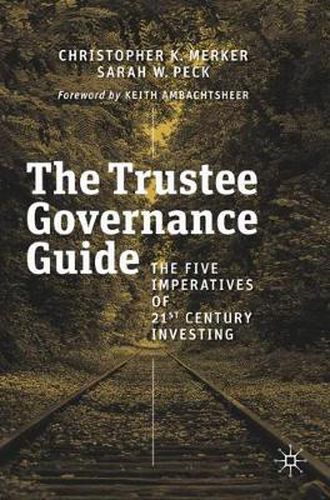Readings Newsletter
Become a Readings Member to make your shopping experience even easier.
Sign in or sign up for free!
You’re not far away from qualifying for FREE standard shipping within Australia
You’ve qualified for FREE standard shipping within Australia
The cart is loading…






This title is printed to order. This book may have been self-published. If so, we cannot guarantee the quality of the content. In the main most books will have gone through the editing process however some may not. We therefore suggest that you be aware of this before ordering this book. If in doubt check either the author or publisher’s details as we are unable to accept any returns unless they are faulty. Please contact us if you have any questions.
More than 80% of the financial assets in the United States fall under the purview of a trustee. That’s a big responsibility for an estimated 1% (around 1.5 million people) of the U.S. working population charged with overseeing investments for millions and millions of beneficiaries, public sector, and non-profit organizations. In a world proliferated by investment products, increasingly dominated by indexes, faced-particularly in the pension world-with increasing liabilities, more regulation, and a growing number of social and sustainability objectives, what’s a trustee to do?
The Trustee Governance Guide is here to help guide today’s board trustee through the brave new world of 21st century investing. The book focuses on the critical aspects of the Five Imperatives: Governance, Knowledge, Diversification, Discipline, and Impact.
Based on more than a decade of research, practice, and discussions with many key decision makers and influencers across the industry, this book addresses the many topics related to better governance, greater mission-driven financial performance, and impact. The questions the book addresses include:
*
What is good governance, how do we know it when we see it, and why does it matter?
*
How much knowledge is necessary to be a competent board member?
*
How big should my endowment be?
*
What are the key elements of a diversified portfolio?
*
How much does cost matter?
*
What’s the difference between socially responsible and ESG investing?
*
Can I focus on sustainability and still be a good fiduciary?
This book provides a way for boards to improve and benchmark their own governance performance alongside their peers, and uniquely covers related investment topics in each chapter.
$9.00 standard shipping within Australia
FREE standard shipping within Australia for orders over $100.00
Express & International shipping calculated at checkout
This title is printed to order. This book may have been self-published. If so, we cannot guarantee the quality of the content. In the main most books will have gone through the editing process however some may not. We therefore suggest that you be aware of this before ordering this book. If in doubt check either the author or publisher’s details as we are unable to accept any returns unless they are faulty. Please contact us if you have any questions.
More than 80% of the financial assets in the United States fall under the purview of a trustee. That’s a big responsibility for an estimated 1% (around 1.5 million people) of the U.S. working population charged with overseeing investments for millions and millions of beneficiaries, public sector, and non-profit organizations. In a world proliferated by investment products, increasingly dominated by indexes, faced-particularly in the pension world-with increasing liabilities, more regulation, and a growing number of social and sustainability objectives, what’s a trustee to do?
The Trustee Governance Guide is here to help guide today’s board trustee through the brave new world of 21st century investing. The book focuses on the critical aspects of the Five Imperatives: Governance, Knowledge, Diversification, Discipline, and Impact.
Based on more than a decade of research, practice, and discussions with many key decision makers and influencers across the industry, this book addresses the many topics related to better governance, greater mission-driven financial performance, and impact. The questions the book addresses include:
*
What is good governance, how do we know it when we see it, and why does it matter?
*
How much knowledge is necessary to be a competent board member?
*
How big should my endowment be?
*
What are the key elements of a diversified portfolio?
*
How much does cost matter?
*
What’s the difference between socially responsible and ESG investing?
*
Can I focus on sustainability and still be a good fiduciary?
This book provides a way for boards to improve and benchmark their own governance performance alongside their peers, and uniquely covers related investment topics in each chapter.